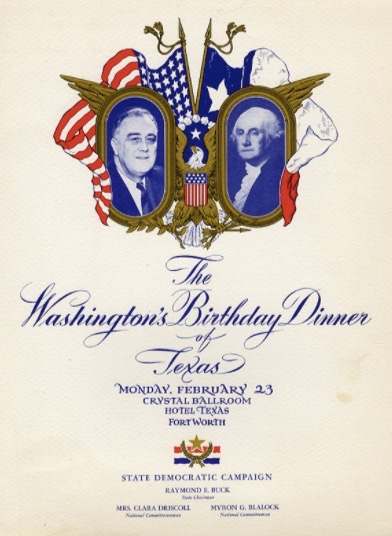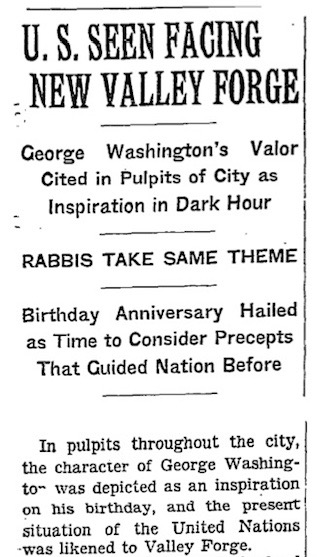 Here are a few more images from my presentation this past Monday at Federal Hall on Presidents Day. Here we see an announcement for a Washington Birthday Democratic fundraiser held in Fort Worth, Texas on February 23, 1942. This was less than two months after Pearl Harbor in those tense days when the United States was getting up to speed in its war effort. The U.S. had been the “arsenal of democracy,” manufacturing tanks, bullets, jeeps, and whatnot for the Allies long prior to Pearl Harbor. Now American fighting men themselves would join the fray. As we see from the announcement the dinner was held on February 23, not Washington’s actually birthday, because the 22nd fell on a Sunday.
Here are a few more images from my presentation this past Monday at Federal Hall on Presidents Day. Here we see an announcement for a Washington Birthday Democratic fundraiser held in Fort Worth, Texas on February 23, 1942. This was less than two months after Pearl Harbor in those tense days when the United States was getting up to speed in its war effort. The U.S. had been the “arsenal of democracy,” manufacturing tanks, bullets, jeeps, and whatnot for the Allies long prior to Pearl Harbor. Now American fighting men themselves would join the fray. As we see from the announcement the dinner was held on February 23, not Washington’s actually birthday, because the 22nd fell on a Sunday.
Roosevelt himself did not attend the dinner, though as we see the Texas Democratic leadership was not hesitant to use his likeness, and on equal footing with President Washington no less. One must remember that Texas in this era was part of the Solid South, comprised, like the rest of the region, of Dixiecrats who since the Civil War eighty years previously had stood against the Party of Lincoln. In the 1930s these leaders, and those who voted for them, were part of the fragile New Deal coalition supporting FDR in cooperation with the Democratic machines of the northern cities. That coalition would hold another three decades until fracturing in the chaos of the Vietnam War and bitterness of the Civil Rights Movement. Roosevelt’s vice-president in his first two terms had been John Nance Garner, a Texan and former Speaker of the U.S. House of Representatives. The tension and unease in their relationship were representative of the strains within the New Deal coalition itself.
Garner was gone by 1942 and now Roosevelt was facing the war in his unprecedented third term. What we see here is the snippet of an article from the February 23, 1942 New York Times describing the mood on Washington’s birthday in those weeks just after Pearl Harbor. The first public observation of George Washington’s birthday had been at Valley Forge in the winter of 1778. Now America was facing a “new Valley Forge.” Attendees at the Fort Worth soiree did not meet Franklin Roosevelt, but they did hear him. That night he gave one of his fireside chats over the radio outlining the progress and stakes of the war, and the lessons to be learned from the experience and difficulties of Washington and the men of his Continental Army all those years earlier.

